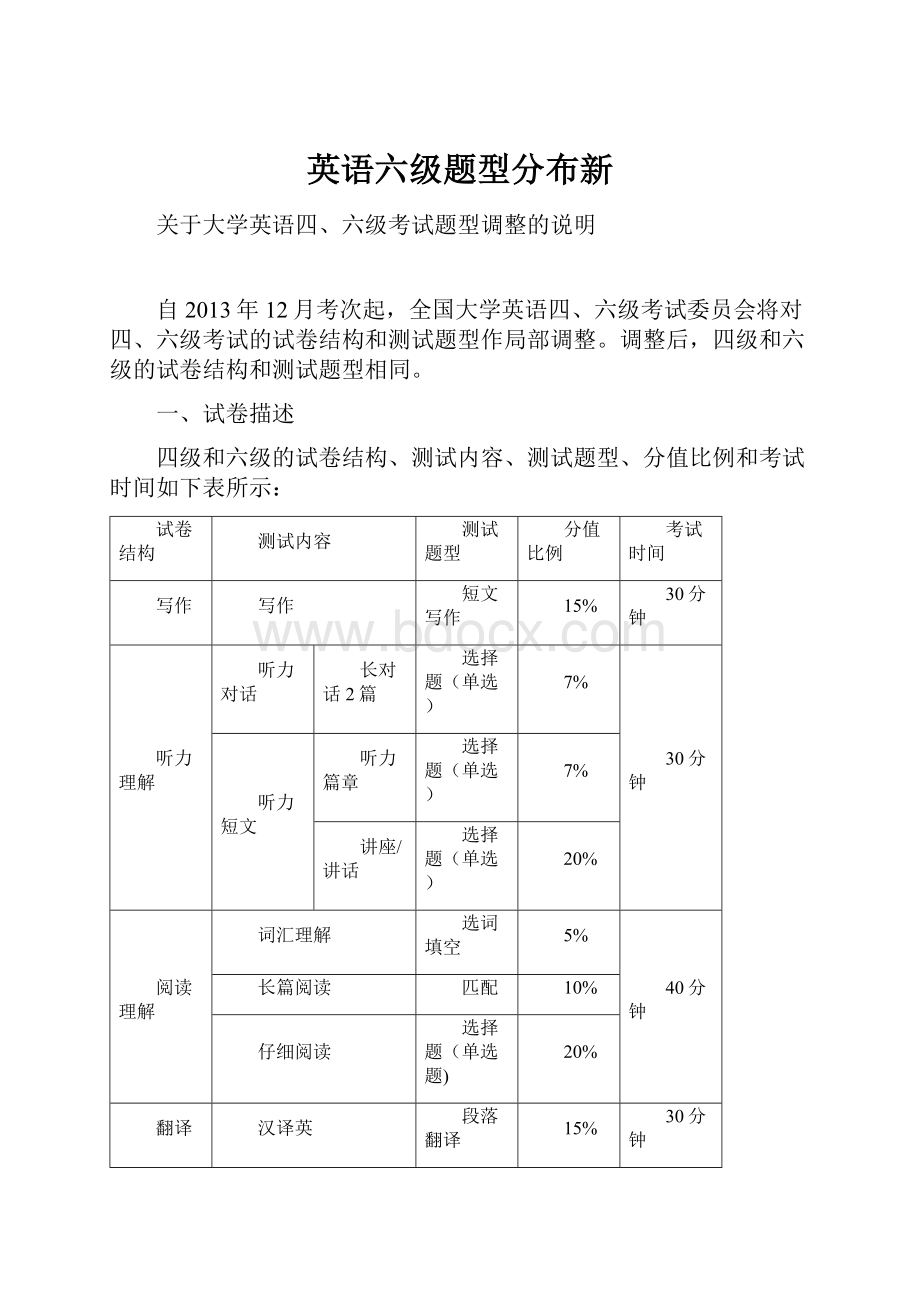英语六级题型分布新.docx
《英语六级题型分布新.docx》由会员分享,可在线阅读,更多相关《英语六级题型分布新.docx(16页珍藏版)》请在冰豆网上搜索。

英语六级题型分布新
关于大学英语四、六级考试题型调整的说明
自2013年12月考次起,全国大学英语四、六级考试委员会将对四、六级考试的试卷结构和测试题型作局部调整。
调整后,四级和六级的试卷结构和测试题型相同。
一、试卷描述
四级和六级的试卷结构、测试内容、测试题型、分值比例和考试时间如下表所示:
试卷结构
测试内容
测试题型
分值比例
考试时间
写作
写作
短文写作
15%
30分钟
听力理解
听力对话
长对话2篇
选择题(单选)
7%
30分钟
听力短文
听力篇章
选择题(单选)
7%
讲座/讲话
选择题(单选)
20%
阅读理解
词汇理解
选词填空
5%
40分钟
长篇阅读
匹配
10%
仔细阅读
选择题(单选题)
20%
翻译
汉译英
段落翻译
15%
30分钟
总计
100%
130分钟
二、新题型说明
1. 单词及词组听写
原复合式听写调整为单词及词组听写,短文长度及难度不变。
要求考生在听懂短文的基础上,用所听到的原文填写空缺的单词或词组,共10题。
短文播放三遍。
2. 长篇阅读
原快速阅读理解调整为长篇阅读理解,篇章长度和难度不变。
篇章后附有10个句子,每句一题。
每句所含的信息出自篇章的某一段落,要求考生找出与每句所含信息相匹配的段落。
有的段落可能对应两题,有的段落可能不对应任何一题。
3. 翻译
原单句汉译英调整为段落汉译英。
翻译内容涉及中国的历史、文化、经济、社会发展等。
四级长度为140-160个汉字;六级长度为180-200个汉字。
三、成绩报道
成绩报道分为总分和单项分。
单项分包括:
1)听力,2)阅读,3)翻译和写作。
大学英语六级考试听力样题
PartII ListeningComprehension (30minutes)
SectionA
Directions:
Inthissection,youwillheartwolongconversations.Attheendofeachconversation,youwillhearsomequestions.Boththeconversationandthequestionswillbespokenonlyonce.Afteryouhearaquestion,youmustchoosethebestanswerfromthefourchoicesmarkedA),B),C)andD).ThenmarkthecorrespondingletteronAnswerSheet1withasinglelinethroughthecentre.
ConversationOne
Questions1to4arebasedontheconversationyouhavejustheard.
1. A)Heinventedtherefrigerator. C)Hewasadmittedtoauniversity.
B)Hepatentedhisfirstinvention. D)HegotadegreeinMathematics.
2. A)Hestartedtoworkonrefrigeration.
B)HebecameaprofessorofMathematics.
C)HefellinlovewithNatashaWilloughby.
D)Hedistinguishedhimselfinlowtemperaturephysics.
3. A)Discoveringthetruenatureofsubatomicparticles.
B)Theirexplanationofthelawsofcauseandeffect.
C)Theirworkonveryhighfrequencyradiowaves.
D)Layingthefoundationsofmodernmathematics.
4. A)Tohaveathree-weekholiday. C)Topatenthisinventions.
B)Tospendhisremainingyears. D)Toteachatauniversity.
ConversationTwo
Questions5to8arebasedontheconversationyouhavejustheard.
5. A)Theinjuryofsomestudents.
B)Aschoolbuscrashontheway.
C)Thecollapseofaschoolbuilding.
D)Afirethatbrokeoutonaschoolcampus.
6. A)Teaching. C)Havinglunch.
B)Onvacation. D)Holdingameeting.
7. A)Amalfunctioningstove. C)Violationoftrafficrules.
B)Cigarettesbuttsleftbyworkers. D)Negligenceinschoolmaintenance.
8. A)Sentastorytothelocalnewspaper.
B)ThrewasmallThanksgivingparty.
C)Bakedsomecookiesasapresent.
D)Wroteapersonalletterofthanks.
SectionB
Directions:
Inthissection,youwillheartwopassages.Attheendofeachpassage,youwillhearsomequestions.Boththepassageandthequestionswillbespokenonlyonce.Afteryouhearaquestion,youmustchoosethebestanswerfromthefourchoicesmarkedA),B),C)andD).ThenmarkthecorrespondingletteronAnswerSheet1withasinglelinethroughthecentre.
PassageOne
Questions9to11arebasedonthepassageyouhavejustheard.
9. A)Itisatraitofagenerouscharacter.C)Itisanindicatorofhighintelligence.
B)Itisareflectionofself-esteem. D)Itisasignofhappinessandconfidence.
10. A)Itwasself-defeating. C)Itwastheessenceofcomedy.
B)Itwasaggressive. D)Itwassomethingadmirable.
11. A)Itisadouble-edgedsword. C)Itisauniquegiftofhumanbeings.
B)Itisafeatureofagivenculture. D)Itisaresultofbothnatureandnurture.
PassageTwo
Questions12to15arebasedonthepassageyouhavejustheard.
12. A)Sheisatouristguide. C)Sheisadomesticservant.
B)Sheisaninterpreter. D)Sheisfromtheroyalfamily.
13. A)Itissituatedatthefootofabeautifulmountain.
B)Itwasusedbythefamilytoholddinnerparties.
C)Itwasfrequentlyvisitedbyheadsofstate.
D)Itisfurnishedlikeoneinaroyalpalace.
14. A)Itiselaboratelydecorated. C)Itisverybig,withonlysixslimlegs.
B)Ithassurvivedsome2,000years. D)ItisshapedlikeanancientSpanishboat.
15. A)Theyareinterestingtolookat.
B)Theyhavelostsomeoftheirlegs.
C)Theydonotmatchtheovaltableatall.
D)Theyareuncomfortabletositinforlong.
SectionC
Directions:
Inthissection,youwillhearrecordingsoflecturesortalksfollowedbysomequestions.Therecordingswillbeplayedonlyonce.Afteryouhearaquestion,youmustchoosethebestanswerfromthefourchoicesmarkedA),B),C)andD).ThenmarkthecorrespondingletteronAnswerSheet1withasinglelinethroughthecentre.
Nowlistentothefollowingrecordingandanswerquestions16to19.
16. A)TheyinvestigatetheretirementhomesinAmerica.
B)TheyareonissuesfacingseniorcitizensinAmerica.
C)Theydescribethegreatpleasuresofthegoldenyears.
D)Theyarefilledwithfondmemoriesofhisgrandparents.
17. A)Thelossoftheabilitytotakecareofhimself.
B)Thefeelingofnotbeingimportantanymore.
C)Beingunabletofindagoodretirementhome.
D)Leavingthehomehehadlivedinfor60years.
18. A)Thelossofidentityandself-worth.
B)Fearofbeingreplacedordiscarded.
C)Freedomfrompressureandworldlycares.
D)Thepossessionofwealthandhighrespect.
19. A)Theurgencyofpensionreform.
B)Medicalcareforseniorcitizens.
C)Findingmeaningfulrolesfortheelderlyinsociety.
D)Thedevelopmentofpublicfacilitiesforseniorcitizens.
Nowlistentothefollowingrecordingandanswerquestions20to22.
20. A)Itseriouslyimpactstheirphysicalandmentaldevelopment.
B)Ithasbecomeaproblemaffectingglobaleconomicgrowth.
C)Itisacommonproblemfoundinunderdevelopedcountries.
D)Itisanissueoftenoverlookedbyparentsinmanycountries.
21. A)Theywilllivelonger. C)Theygetalongwellwithpeople.
B)Theygetbetterpay. D)TheydevelopmuchhigherIQs.
22. A)Appropriatedfundstopromoteresearchofnutrient-richfoods.
B)Encouragedbreastfeedingforthefirstsixmonthsofachild’slife.
C)Recruitedvolunteerstoteachruralpeopleabouthealthandnutrition.
D)Targetedhunger-reliefprogramsatpregnantwomenandyoungchildren.
Nowlistentothefollowingrecordingandanswerquestions23to25.
23. A)Theguaranteedqualityofitsgoods.
B)Thehugevolumeofitsannualsales.
C)Theserviceitprovidestoitscustomers.
D)Thehighvalue-to-weightratioofitsgoods.
24. A)Thosehavingatasteorsmellcomponent.
B)Productspotentiallyembarrassingtobuy.
C)Thosethatrequireverycarefulhandling.
D)Servicesinvolvingapersonalelement.
25. A)Thosewholiveinthevirtualworld.
B)Thosewhohavetoworklonghours.
C)Thosewhoareusedtoonlinetransactions.
D)Thosewhodon’tmindpayingalittlemore.
TapeScriptofListeningComprehension
SectionA
Directions:
Inthissection,youwillheartwolongconversations.Attheendofeachconversation,youwillhearsomequestions.Boththeconversationandthequestionswillbespokenonlyonce.Afteryouhearaquestion,youmustchoosethebestanswerfromthefourchoicesmarkedA),B),C)andD).ThenmarkthecorrespondingletteronAnswerSheet1withasinglelinethroughthecentre.
ConversationOne
W:
Hello.
M:
Hello,isthatthereferencelibrary?
W:
Yes.CanIhelpyou?
M:
Ihopeso.IrangearlierandaskedforsomeinformationaboutDenysHawtin,thescientist.Youaskedmetoringback.
W:
Oh,yes.Ihavefoundsomething.
M:
Good.I’vegotapencilandpaper.Perhapsyoucouldreadoutwhatitsays.
W:
Certainly.Hawtin,Denys.Born:
Darlington1836;diedNewYork1920.
M:
Yes.Gotthat.
W:
Inventorandphysicist.Thesonofafarmworker,hewasadmittedtotheUniversityofLondonattheageoffifteen.
M:
Yes.
W:
HegraduatedatseventeenwithafirstclassdegreeinPhysicsandMathematics.Allright?
M:
Yes,allright.
W:
Hemadehisfirstnotableachievementattheageofeighteen.Itwasamethodofrefrigerationwhicharosefromhisworkinlowtemperaturephysics.HebecameprofessorofMathematicsattheUniversityofManchesterattwenty-four,whereheremainedfortwelveyears.Duringthattimehemarriedoneofhisstudents,NatashaWilloughby.
M:
Yes.Goon.
W:
Later,workingtogetherinLondon,theylaidthefoundationofmodernPhysicsbyshowingthatnormallawsofcauseandeffectdonotapplyatthelevelofsubatomicparticles.ForthisheandhiswifereceivedtheNobelPrizeforPhysicsin1910,anddidsoagainin1912fortheirworkonveryhighfrequencyradiowaves.InhislifetimeHawtinpatented244inventions.Doyouwantanymore?
M:
Yes.WhendidhegotoAmerica?
W:
Letmesee.In1920hewenttoteachinNewYork,anddiedtheresuddenlyafteronlythreeweeks.Still,hewasagoodage.
M:
Yes.Isupposeso.Well,thanks.
Questions1to4arebasedontheconversationyouhavejustheard.
1.WhatdowelearnaboutDenysHawtinwhenhewas15?
2.WhatdidDenysHawtindoattheageof24?
3.ForwhatwereDenysHawtinandhiswifeawardedtheNobelPrizeasecondtime?
4.WhydidDenysHawtingotoNewYork?
ConversationTwo
W:
ThisisLisaMeyerintheWBZnewsroom,talkingwithMikeBassichis,whoisthedirectoroftheGiffordSchool,aboutthecleanupfromlastweek’sfireandwhatthepossiblecauseofthatblazemayhavebeen.
M:
We’regettingreadyforourentirestafftoreturnearlyfromvacationtomorrowwhereuponwearegoingtomoveintotemporaryclassrooms.And